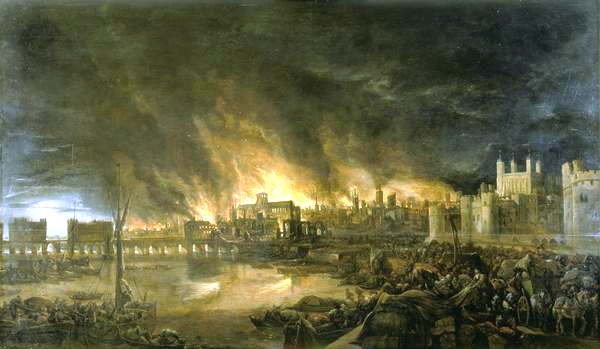<![CDATA[The fire started in the house of King Charles II's baker, Thomas Farynor, in Pudding Lane near London Bridge. His workers raised the alarm at 2:00 am and evacuated the house. The family escaped by climbing across nearby rooftops, although one maid was left in the building, becoming the fire's first victim. A strong easterly wind meant the fire had already spread to Thames Street, a warehouse district full of combustibles that quickly accelerated the fire's advance. At this time London was largely made up of narrow streets densely packed with wooden buildings. Provision for the outbreak of a fire was limited to local community led 'bucket brigades,' that had nothing more than pails of water and basic hand pumps. These factors meant the fire was able to spread with uncontrollable speed and little resistance. Although isolated to the medieval City of London - the area within the Roman Walls, its effect was ferocious. In the end 13,200 houses were burned down, meaning 70,000 of the city's 80,000 inhabitants lost their homes. Most of the buildings belonging to the city authorities were destroyed, as well as 87 churches, including the Old St. Paul's Cathedral. Efforts to fight the fire were just as damaging as the fire itself. Under King Charles II's orders, militias and workers demolished wooden houses to create 'breaks' that would stop the flames. Because of the strong winds, the fire was capable of jumping a distance of twenty houses, leading to an absurd situation where workers were destroying huge amounts of property to prevent the fire destroying huge amounts of property. Ultimately a break in the wind, as well as the fire being slowed when it reached brick walls at Mid Temple and Fetter Lane, meant that the demolitions succeeded in halting the fire. England in 1666 was a country coming to terms with a variety of major upheavals. Oliver Cromwell had died in 1658, bringing about a series of events culminating in the Restoration of the Monarchy in the United Kingdom under Charles II. This created tension and suspicion between Catholics and Republicans, as the monarchy begun to adapt to a constitution. The country was also at war with both the French and Dutch, something that caused increasing xenophobia in the ethnically diverse capital. Finally, the city was under attack from the Plague. The disease had killed 68,000 Londoners in the two years prior to 1666, and showed little sign of stopping. After the fire the city's population looked for somebody to blame. This led to accusations of foreign espionage and suspicions between Catholics and Republicans. The Parliamentary Committee reported in January 1667 that the fire had been nothing more than an act of God. Despite this conclusion, various conspiracy theories circulated for years afterwards. For 150 years, the first commemorative monument made reference to the 'treachery and malice of the Popish faction' in starting the fire. What's clear is that in the chaotic England of the seventeenth century, a time of civil wars, plagues, and decapitated kings, a great fire in the capital city doesn't seem so out of place. ]]>
The Great Fire of London
